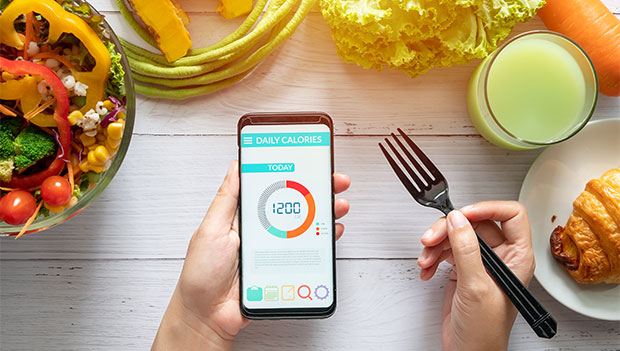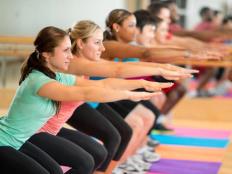
How to Lose Weight Fast | Workouts to Lose Weight | How to Lose Weight Without Exercise | How to Eat to Lose Weight | How to Burn Belly Fat | Best Weight Loss Apps | Fat-Burning Foods | Best Fat Burners | Best Weight-Loss Supplements
It may seem simple: Take in fewer calories than you burn on a regular basis, and you will lose weight. Although this is true on the surface, you need to know exactly how many calories to eat to lose weight fast without sacrificing your lean muscle or athletic performance. In this article we'll guide you through calculating your calories for weight loss and provide you with some practical ways to maintain a healthy deficit, without losing your hard-earned muscle or performance.
What Are Calories?
Calories are a unit of energy used to establish the energy value of food. They provide our bodies with life-sustaining energy to carry out daily tasks. When we eat food, it's broken down to release this energy either for immediate use or to be stored for later use, depending on our needs.
In general, if you eat more calories than your body uses on a daily basis you will tend to gain weight, whereas when you eat fewer calories than you need, you will most often lose weight.
How Many Calories Should You Eat to Lose Weight?
When determining how many calories you need to eat on average to lose weight, the first question you have to ask yourself is how quickly you want to lose it. While most people will probably say "as quickly as possible," there are some benefits to losing weight at a slower rate. Most notably, you may be more likely to keep the weight off if you lose it at a more gradual rate. In addition, losing weight more slowly will allow you to better maintain your muscle mass, an important factor in body composition.
To determine how many calories you need to eat to lose weight, start by calculating your maintenance calories, or how many calories you need to maintain your weight. This can be done by referring to the charts below or using a calorie calculator, which may be a bit more accurate.
From there you'll subtract a given number of calories to establish a calorie deficit. There's no set-in-stone number of calories that will promote weight loss, though in general, a deficit of 500-1,000 calories should allow for weight loss of 1-2 pounds per week. It's best to start on the lower end and gradually increase the deficit as your weight-loss progress slows. In some cases, you may even gain a pound or two before you start losing weight.
To establish more individualized caloric needs and weight-loss strategies, it may be beneficial to speak with a registered dietitian in your area.
Daily Calorie Requirement Charts for Men and Women by Age
When establishing how many calories you need to eat to lose weight, it's important to know your maintenance calories. The charts below will tell you your maintenance calories based on your sex, age, and level of physical activity.
Daily calorie requirements for men:
| Age | Sedentary | Active | Very active |
| 18 | 2,400 | 2,800 | 3,200 |
| 19-25 | 2,600 | 2,800 | 3,000 |
| 26-35 | 2,400 | 2,600 | 3,000 |
| 36-40 | 2,400 | 2,600 | 2,800 |
| 41-45 | 2,200 | 2,600 | 2,800 |
| 46-55 | 2,200 | 2,400 | 2,800 |
| 56-65 | 2,000 | 2,400 | 2,600 |
| 66-75 | 2,000 | 2,200 | 2,600 |
| 76+ | 2,000 | 2,200 | 2,400 |
Daily calorie requirements for women:
| Age | Sedentary | Active | Very active |
| 18 | 1,800 | 2,000 | 2,400 |
| 19-25 | 2,000 | 2,200 | 2,400 |
| 26-30 | 1,800 | 2,000 | 2,400 |
| 31-50 | 1,800 | 2,000 | 2,200 |
| 51-60 | 1,600 | 1,800 | 2,200 |
| 61+ | 1,600 | 1,800 | 2,000 |
It's important to note that the daily requirements for women do not take into account women who are pregnant or breastfeeding, as they will need significantly more calories.
For most women, losing weight while pregnant or breastfeeding is not recommended, thus it's best to consult your healthcare provider.
How to Create a Healthy Calorie Deficit
Now that we've established how many calories you should eat to lose weight, we'll cover some of the top science-backed strategies to create a calorie deficit without sacrificing your health.
Focus On Lean Protein and Veggies
In order to reduce your calories to promote weight loss, it's common sense that you'll have to reduce your food intake. But where should these calories come from?
Generally speaking, most people see sustainable weight-loss success by reducing their intake of refined carbs, such as white breads and sweets, and replacing them with smaller portions of more fibrous carbs such as whole grains and beans. In addition, it's helpful to replace fatty foods such as pizza and fried foods, with healthier fat sources such as avocado, nuts and nut butters, seeds, and olive oil.
To help manage hunger levels and make up for the calories you are removing from your diet, it's best to boost your intake of lean proteins and veggies. These foods tend to fill you up while providing fewer calories, making them ideal for weight loss. Some common examples include grilled chicken over salad, fish with whole-grain pasta or zucchini noodles, or a tofu stir-fry with plenty of veggies.
Control Your Portion Sizes
Managing your portion sizes may be one of the most important aspects of maintaining a weight-loss diet. By simply reducing the size of your portions, you can still eat many of the foods you enjoy, though with fewer calories.
Some people find it helpful to measure out their foods with a food scale or measuring cup to get an idea of a proper portion size. Certain apps like Noom or Weight Watchers can also help with food tracking. Instead of two or three servings of pasta, have just one, or instead of a whole cup of rice have half a cup.
By quantifying your portion sizes, you may be surprised at how big your portions were prior to eating for weight loss.
Ditch Sugary Drinks
This is another area where you can reduce your intake of refined carbs. By eliminating sugar-sweetened drinks, you can easily reduce your calorie intake—especially since the calories provided by many sugary drinks are "empty," meaning they don't provide any nutrients. Your brain doesn't register calories from beverages the same way it does from food, so even if they contain calories, they often don't impact your hunger or fullness, making them easy to over consume without noticing.
Swap out sugary drinks for water, seltzers, and other calorie-free beverages. In addition, drinking water before meals may help keep you full, further aiding you in maintaining a calorie deficit.
Get Moving

While weight loss can be achieved with diet alone, incorporating a regular exercise program into your weight-loss plan can significantly boost your progress as it can add to your overall calorie deficit, allowing you to lose weight at a faster rate.
For the best results, include a combination of cardio and resistance (strength-building) exercise. In terms of weight loss, cardio works to help you burn calories, whereas resistance training helps you build muscle. Having more lean muscle mass can help improve your metabolism, which in turn facilitates weight loss.
Prep Your Meals Ahead of Time
A significant factor that throws people off when dieting for weight loss is being unprepared.
Here is a common scenario: You have a balanced, healthy breakfast to start the day, but when you get ready to head to work, you realize there's nothing to take for lunch. You think to yourself, "Oh, I'll just grab something nearby." Then lunchtime rolls around and you are busy as ever and don't think you'll have time to run out to grab something, thus you end up settling for a vending machine snack to hold you over until dinner. On your way home, you are ravenous since you didn't have a proper lunch. You pass by several fast food restaurants on the way home and figure, "I guess I'll just stop to get something since I am starving."
A scenario like this could be avoided if you do a bit of meal preparation in advance:Stock up on healthy foods that you know are in line with your diet.Prepare your lunch the night before so you can easily grab it and go in the morning.Keep healthy snacks at work in case you aren't able to bring lunch. If you don't have time to cook, consider a meal prep service
You don't need to prepare an entire week's worth of meals in advance, though consider having nutritious options on hand so that making healthy meal choices is much easier.
Potential Downsides of Maintaining a Calorie Deficit
When maintaining a calorie deficit to promote weight loss, there are a few potential downsides that you should be aware of.
In most cases, negative side effects stem from dropping your calories too low. The goal of a proper weight-loss diet is to allow you to gradually lose weight while still meeting all of your daily nutrient needs. When dropping calories too low, you sacrifice your nutrition needs for faster weight loss. This is why many fad diets are not healthy or sustainable and result in rapid weight regain.
Some potentially serious side effects of lowering your calories too much include headaches, dizziness, feelings of hunger, slowed metabolism, rapid weight regain, loss of muscle mass, decrease in athletic performance, and risk of a nutrient deficiency, among others.
The best method of achieving weight loss while avoiding potential negative side effects is to follow a slow, gradual approach. This allows your body to adapt to the changes you've made and sets you up for success when maintaining your weight loss.
Final Takeaway
The number of calories you need to lose weight will depend on several factors including your sex, level of activity, age, and how fast you'd like to lose it. The most simplified method is to establish your maintenance calories using a calorie calculator and subtract 500-1,000.
A healthy approach to maintain a calorie deficit includes focusing on eating lean protein and veggies, controlling your portions, swapping sugary drinks for water, being active, and prepping meals in advance.
Beware of dropping your calories too low, as this can result in some potentially serious side effects. Try to make small, sustainable changes which scan result in lasting weight loss success.
How to Lose Weight Fast | Workouts to Lose Weight | How to Lose Weight Without Exercise | How to Eat to Lose Weight | How to Burn Belly Fat | Best Weight Loss Apps | Fat-Burning Foods | Best Fat Burners | Best Weight-Loss Supplements
Get ACTIVE on the Go


Couch to 5K®
The best way to get new runners off the couch and across the finish line of their first 5K.
Available for iOS | Android








Discuss This Article